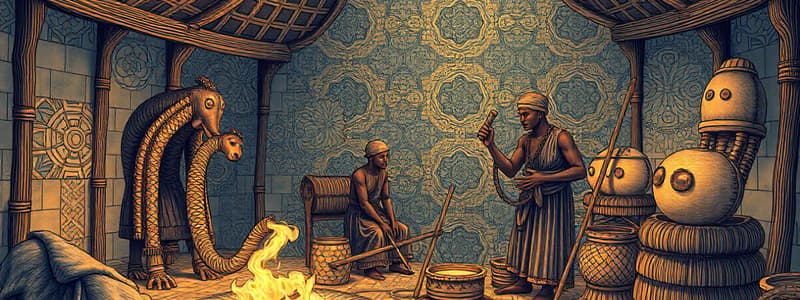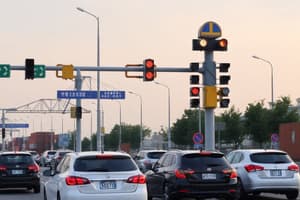Podcast
Questions and Answers
What is the primary way that the word "captivate" describes the ability of griots to perform?
What is the primary way that the word "captivate" describes the ability of griots to perform?
- Griots used their performances to educate and entertain.
- Griots used their performances to spread knowledge and stories.
- Griots used their performances to create a sense of wonder and excitement. (correct)
- Griots used their performances to demonstrate their skill and talent.
What is a potential disadvantage of passing down history through oral tradition?
What is a potential disadvantage of passing down history through oral tradition?
- Information can be lost over time due to changes and inconsistencies.
- It can be difficult to verify the accuracy of the information.
- Oral traditions can limit the amount of information that can be passed down.
- All of the above. (correct)
Based on the text, what is a piece of evidence that suggests Mansa Musa was immensely wealthy?
Based on the text, what is a piece of evidence that suggests Mansa Musa was immensely wealthy?
- He was a devout Muslim.
- He brought many gifts to Cairo. (correct)
- He built mosques and schools during his travels.
- His travels to Cairo were well-documented.
From Document Two, why does the map suggest that Mansa Musa was important to West Africa?
From Document Two, why does the map suggest that Mansa Musa was important to West Africa?
What is the significance of the item that Mansa Musa is holding in Document Two?
What is the significance of the item that Mansa Musa is holding in Document Two?
What geographical feature forms the northern border of Africa and borders the Mediterranean Sea?
What geographical feature forms the northern border of Africa and borders the Mediterranean Sea?
What is the most accurate description of the Sahara Desert’s climate?
What is the most accurate description of the Sahara Desert’s climate?
What is the primary factor contributing to the process of desertification?
What is the primary factor contributing to the process of desertification?
How did the introduction of camels impact trans-Saharan trade?
How did the introduction of camels impact trans-Saharan trade?
Why were oases in the Sahara important locations for traders?
Why were oases in the Sahara important locations for traders?
What was the primary reason for the decline of the Nok culture?
What was the primary reason for the decline of the Nok culture?
How did the king of Ghana ensure the high price of gold?
How did the king of Ghana ensure the high price of gold?
What role did middlemen play in the kingdom of Ghana?
What role did middlemen play in the kingdom of Ghana?
Why was the location of Koumbi-Saleh, the capital of Ghana, considered ideal?
Why was the location of Koumbi-Saleh, the capital of Ghana, considered ideal?
What was the main reason for the flourishing of Timbuktu as a center of Islamic learning?
What was the main reason for the flourishing of Timbuktu as a center of Islamic learning?
What is the primary function of griots in early African civilizations?
What is the primary function of griots in early African civilizations?
What significant idea did trade bring to both Ghana and Mali?
What significant idea did trade bring to both Ghana and Mali?
How did Mansa Musa become so incredibly wealthy?
How did Mansa Musa become so incredibly wealthy?
Flashcards
Nok people
Nok people
The first in Africa to make tools from iron.
Terra cotta
Terra cotta
Fire-baked clay used for human sculptures.
Iron Age
Iron Age
A period characterized by the widespread use of iron tools and weapons.
Smelting
Smelting
Signup and view all the flashcards
Koumbi-Saleh
Koumbi-Saleh
Signup and view all the flashcards
Griots
Griots
Signup and view all the flashcards
Mansa Musa
Mansa Musa
Signup and view all the flashcards
Timbuktu
Timbuktu
Signup and view all the flashcards
Griots' Performance
Griots' Performance
Signup and view all the flashcards
Oral Tradition Advantages
Oral Tradition Advantages
Signup and view all the flashcards
Mansa Musa's Wealth
Mansa Musa's Wealth
Signup and view all the flashcards
Reliable Information
Reliable Information
Signup and view all the flashcards
Trans-Saharan Trade
Trans-Saharan Trade
Signup and view all the flashcards
Caravan Purpose
Caravan Purpose
Signup and view all the flashcards
Importance of Oases
Importance of Oases
Signup and view all the flashcards
Valuable Salt
Valuable Salt
Signup and view all the flashcards
Slavery in North Africa
Slavery in North Africa
Signup and view all the flashcards
Islam Spread by Berber Merchants
Islam Spread by Berber Merchants
Signup and view all the flashcards
Study Notes
Nok People
- First in Africa to create iron tools.
- Crafted iron tools.
- Deforestation and soil overuse led to their culture's decline.
- Their practices like mass deforestation and soil overuse disrupted the environment.
Terracotta
- Fire-baked clay used to make human sculptures.
- Used to create sculptures of people.
Iron Age
- Period where superior iron tools and weapons became widespread.
- Mass production of superior iron tools and weapons.
- Iron technology revolutionized tools and weapons.
Smelting and Nok Culture
- Smelting was crucial for Nok's iron tool production.
- Essential for producing iron tools for the Nok civilization.
Ghana's Location and Trade
- Koumbi-Saleh, Ghana's capital, was centrally located near gold mines and salt sources.
- Ideal location for trade.
- Strategic position for trade and resource acquisition.
Middlemen in Ghana
- Middlemen are individuals who buy goods from one seller and sell to another.
- Ghanaian traders were successful middlemen, generating wealth and power from trade activities.
- Successfully played the role of middlemen in trading activities.
Ghana's Economy
- Ghana's king taxed salt and other goods as they passed borders.
- Relied on taxation of trade goods for revenue.
- Generated income from taxes on trade items.
Ghana's Gold
- The king owned all gold nuggets, limiting supply and increasing prices.
- Regulated the gold market to maintain high prices.
- King controlled gold trade to maintain high value.
Islam in Ghana
- Almoravid conquest introduced Islam to Ghana.
- Invasion led to the spread of Islam in Ghana, and eventual conversions.
- Religious conversion influenced by military conquest.
Sundiata Keita
- Founder of the Mali Empire.
- Instituted legal structure and peace.
- Brought law and order and tolerance, to Mali.
Mansa Musa's Wealth
- Mansa Musa received tribute from other kings and levied taxes on merchants.
- Gained immense wealth through a combination of tribute and taxes.
- Earned wealth through tributes and trade revenues.
Mansa Musa and Patronage
- Supported arts, learning, and Islam.
- Promoted Islamic learning in Timbuktu.
- Encouraged Timbuktu as an Islamic learning center.
Timbuktu's Religious Significance
- Timbuktu became a significant Islamic center in the 1500s.
- Important religious center in Africa.
Ghana and Mali Trade's Impact
- Trade brought wealth and resources to Ghana and Mali.
- Trade increased influence of the African empires.
- Economic and cultural impact through trade routes.
Griots
- Oral storytellers who preserved history, memory, genealogy, and narratives.
- Crucial for preserving history and knowledge in their societies.
- Important for upholding cultural history and knowledge transfer.
Oral Tradition
- Oral method of conveying history and tales.
- Passing down narratives from generation to generation verbally.
- Preserving history through spoken word.
Griots' Role
- Griots told stories at ceremonies and gatherings.
- Served as entertainers and educators preserving their culture's history.
- Served as crucial keepers and performers of the oral tradition.
Oral Tradition: Advantages and Disadvantages
- Oral tradition preserves cultural memory, but information may change over time.
- Passing down stories creates a unique way of transmitting knowledge across generations.
- Flexibility with narratives, yet possibility of distortion.
Document Analysis: Mansa Musa
- Mansa Musa's wealth and religious devotion were crucial to his legacy.
- Al-Umari's account's reliability regarding Mansa Musa's visit to Cairo is unclear.
- Mansa Musa's importance in West African history is emphasized through diverse means.
Document Analysis (Map)
- Mansa Musa's wealth and power significantly impacted West African history.
- Wealth is demonstrated in images associated with his persona.
Document Analysis (Mansa Musa's Holding)
- Mansa Musa likely holds gold, symbolizing his immense wealth.
- Gold represented wealth and status in his era.
Document Analysis (Portrayal)
- Portrayal of individuals suggests their social status and roles.
- Images convey information about trade routes, cultural roles.
North African Geography
- Atlas Mountains border the Mediterranean Sea on north Africa.
- Part of the geographical features of north Africa.
Sahara Desert
- Largest desert globally, spanning thousands of miles.
- The Red Sea is on the east border, and the Atlantic Ocean is on the west.
- Crucial geographic feature of northern Africa.
Sahara Climate
- Extremely hot and dry climate.
- Warm winters.
- Harsh weather conditions characterize the Sahara desert.
Savannah
- Lush tropical grassland from the dried-up seas.
- Result of climate change.
Desertification
- Process of land degradation in dry, arid regions.
- Loss of water resources and fertile lands.
- Climate changes impact on the environment, leading to the degradation of land.
Trans-Saharan Trade
- Trade routes that linked North and Sub-Saharan Africa.
- Camels revolutionized trade across the Sahara.
- Introduction of camels created new possibilities in the trade routes.
Camels in Trade
- Camels facilitated long-distance trade, with their strength and endurance.
- Important animals for carrying goods across the Sahara.
- Camels were crucial for the success of trade routes.
Caravans
- Groups of merchants traveling together for protection and safety.
- Effective way to navigate the harsh climate and desert routes.
- Protection against dangers on the trade routes.
Oases
- Oasis served as crucial stopping points where traders could find water and supplies.
- Provided vital resources for traders.
- Important for supplying water to travelers on trans-Saharan trade routes.
Lake Chad, Gao and Alexandria Trade Routes
- Traveling around Lake Chad might be advantageous to avoid mountains and potentially procure slaves.
- Alternative trade routes.
- Importance of navigation on trade routes.
Gold and Salt Trade
- Gold and salt were the primary commodities traded.
- Essential resources sought across significant trade routes.
- Salt was important commodity among the two.
Salt's Value
- Scarcity made salt extremely valuable.
- Lack of refrigeration prevented preservation.
- Limited access to salt impacted trade economics.
Scarcity and Salt Prices
- Salt's scarcity drove up its price.
- High demand and limited supply.
Slaves
- Used primarily for mining, agriculture, and other labor.
- Slaves were part of the trade route activities.
- Slaver were crucial for supplying labor.
Slaves in North Africa
- Harsh conditions often led to slave deaths.
- Slaves were exchanged for goods and horses.
- Trade items often offered in exchange for slaves.
Islam's Spread Across Sahara
- Berber merchants played a prominent role in spreading Islam across the Sahara.
- Islamic spread through trading.
- Religious diffusion along the popular trade routes.
West African Islamic Conversion
- West African rulers converted to Islam by the 1000s.
- Conversion through trade relations.
Ideas Carried Across Sahara
- Islam and its associated ideas and practices were carried across the Sahara.
- Spread of knowledge and beliefs between different regions.
- Islamic ideals found their way to northern and sub-Saharan regions.
Islamic Conversion Advantages
- Conversion to Islam could offer trading advantages and opportunities.
- Access to wider trading network and opportunities.
- Easier trade with other societies.
Mosque Architecture Adaptation
- Traditional mosque designs adapted to African climates.
- Showing how architecture can change to suit diverse cultural contexts.
Studying That Suits You
Use AI to generate personalized quizzes and flashcards to suit your learning preferences.



